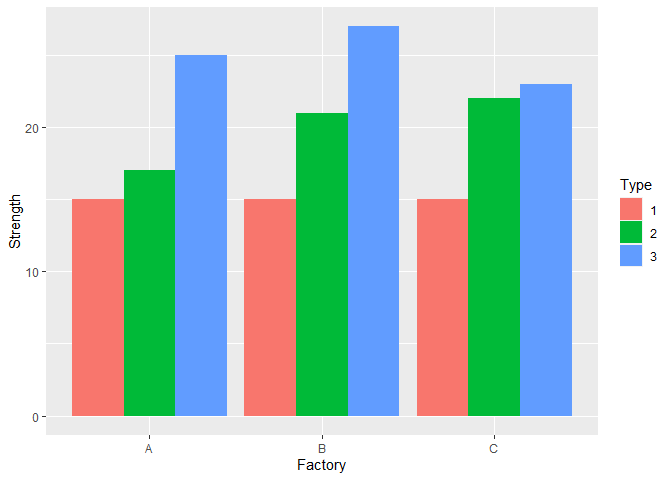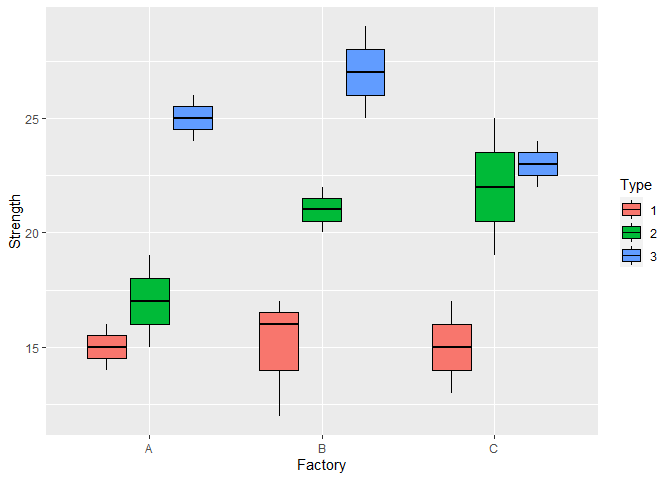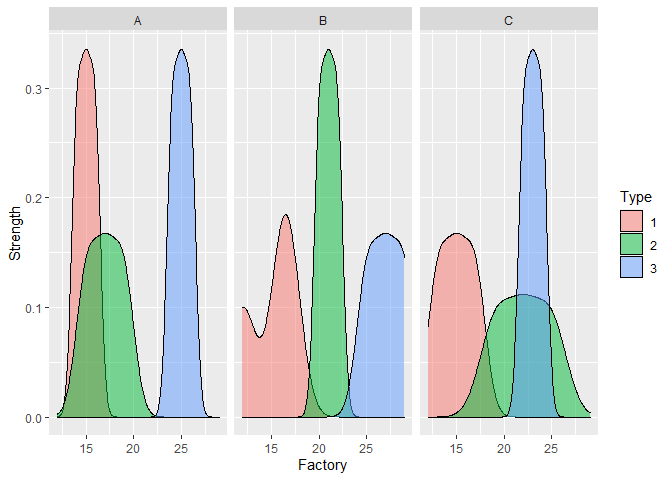Data visualization (Introduction to statistics)
First we need to load the R libraries. If you get an error when running the codes below, it might mean that you don’t have the packages downloades, so you should run the commented lines below.
#install.packages('ggplot2')
#install.packages('dplyr')
library(ggplot2)
library(dplyr)
Now we define the dataset.
data = data.frame(Type = as.character(c(1, 1, 1, 1, 1, 1,
1, 1, 1, 2, 2, 2,
2, 2, 2, 2, 2, 2,
3, 3, 3, 3, 3, 3, 3, 3, 3)),
factory = c('A', 'A', 'A', 'B', 'B', 'B',
'C', 'C', 'C', 'A', 'A', 'A',
'B', 'B', 'B', 'C', 'C', 'C',
'A', 'A','A', 'B', 'B', 'B', 'C', 'C', 'C'),
strength = c(14, 15, 16, 16, 12, 17,
17, 15, 13, 15, 17, 19,
20, 21, 22, 19, 22, 25,
26, 25, 24, 25, 27, 29, 22, 23, 24))
Now we make use of a very handy function from dplyr, called summarize.
summarizing <-
plyr::ddply(data, c("Type", "factory"), summarise, #here I define what variables I want to stack together
N = length(strength), #gettint the N for each sample
mean = mean(strength, na.rm = TRUE), #getting the mean
sd = sd(strength, na.rm = TRUE), #getting the standar deviation
se = sd / sqrt(N)) #getting the standard error
Now let us take a look at what dplyr returns. It is kinda like the pivot table function from excel (wich I don’t use anymore because R, or pandas, in Python is much cooler lol).
head(summarizing)
## Type factory N mean sd se
## 1 1 A 3 15 1.000000 0.5773503
## 2 1 B 3 15 2.645751 1.5275252
## 3 1 C 3 15 2.000000 1.1547005
## 4 2 A 3 17 2.000000 1.1547005
## 5 2 B 3 21 1.000000 0.5773503
## 6 2 C 3 22 3.000000 1.7320508
Now let us visualize. Here I plot a somewhat out of date kind of visualization. Recend papers tend to plot something which allows us to get a good idea of the distribution behind our dataset, so take a look at what violine plots, boxplots, scatterplots, and densityplot can do for you.
Well, here we use te ggplot2 library.
ggplot(summarizing, aes(x = factory, y = mean, fill = Type))+
geom_bar(stat = "identity", position="dodge")+
ylab('Strength')+
xlab('Factory')

I particularly like visualizing boxplots, since they allow us to have an idea about the distribution, as well as a measure of central tendency.
ggplot(data, aes(x = factory, y = strength, colour = Type, fill = Type))+
geom_boxplot(colour = 'black')+
ylab('Strength')+
xlab('Factory')

A somewhat weird density plot, which shows the distribution for each facotry and glass type.
ggplot(data, aes(x = strength, fill = Type))+
facet_wrap(~factory)+
geom_density(alpha = 0.5)+
ylab('Strength')+
xlab('Factory')

The possibilities are infinite, and the only risk of learning to use ggplot is spending way too much time there, when you should be doing something else lol :D